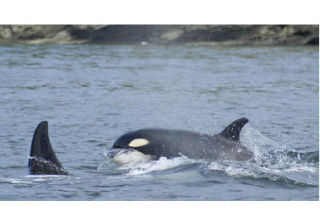The Center for Whale Research has confirmed the birth of a new K pod calf. If it survives that critical first year, the Southern resident orca population is 90, its highest since 2006. The Center for Whale Research designated the calf K43. Center researcher Erin Heydenreich said the calf is the fifth born to K12. However, only three of those orcas are still alive, Heydenreich said.
Heydenreich photographed the calf Wednesday in Haro Strait off Stuart Island. It’s the first Southern resident calf recorded since L114 was photographed swimming with its mother, L77, Feb. 21 in Cordova Bay.
The three Southern resident pods — called “residents” because they spend a majority of the year here — are considered endangered by the United States and Canada. Their population, believed to have been historically in the high 100s, was decimated by captures for marine parks, which ended in the 1970s, followed by pollution and declining salmon populations.
The whales’ population was 71 by 1973, climbed to 99 by 1995, then plummeted to 79 six years later. The population rebounded to 80 in 2002, 83 in 2003, 85 in 2004 and 89 in 2005, and has seesawed around 88 since then. The whales were declared endangered by the U.S. and Canada by 2005.
Heydenreich said the population actually reached 90 in 2006, but then six whales failed to return with their pods later that year and were presumed dead.
As of Thursday, the population breaks down this way: J pod, 28; K pod, 20; L pod, 42. But researchers are holding their breath on those numbers; the L pod orca born over the winter has not been seen yet. “We don’t think it’s still around, but a whole bunch of L’s are not back yet,” she said.





